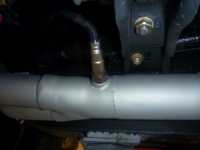How so? It's still a ways from the tailpipe so leakage is not a factor.
That seems a bit too far down to me.
That seems a bit too far down to me.
How so? It's still a ways from the tailpipe so leakage is not a factor.
i think the o2 sensor should sample gases from all cylinders. accordingly, my thought with the stahl headers is to either create a connector pipe in the two horizontal tubes before it enters the resonator ... and have the bung mounted in that. if the exhaust i end up using has a "y" connector to a single pipe, then i will have a bung put in the single pipe.
The O2 sensor is heated by voltage, not the exhaust gas, yes? So it shouldn't matter where it is as long as fresh air isn't back flowing up to it?
That wooshing sound is the technology going right over my head! Doesnt the amount of oxygen create the resistance/voltage that is read by the computer, not the heat of the gas? I dunno.
At temperatures in excess of 300°C the zirconia element possesses a property that causes a transfer of oxygen ions. This movement creates a voltage. The greater the difference of oxygen concentration between the exhaust gas and the ambient reference air in the centre of sensor thimble the higher the voltage produced. The voltage produced in the fuel lean position should be approximately 0.1 volt and in the fuel rich position approximately 0.9 volt. The very useful part of this function is that at around the stoichiometric point there is a relatively large change in voltage. This allows the sensor to keep the engine emissions within strict limits by constantly bringing the fuelling system back from a fuel lean or fuel rich position to retain the stoichiometric mixture. The time taken to switch from fuel lean to fuel rich is approximately 300 milliseconds.
so i presume you have 2 downpipes ... therefore my theory has been debunked and i don't need to worry about creating a connector between the 2 pipes before the resonator. COOL.

Not sure if this is a dumb question or not, but: what is an H pipe (relative to our cars' exhaust path)? I believe the two down pipes connect to the double entry resonator on a stock set-up. And in a non-stock, higher flow center resonator type (ala Coupe King and what I currently plan on doing), the two secondaries get combined into one final pipe (also where I plan to locate the O2 sensor).
View attachment 40379
Picture is of the Coupe King exhaust set-up...
I am familiar with this in a V8 system, which would include a full/true dual exhaust all the way back. Didn't realize that folks were doing it with the e9, since the two down pipes join/combine in the first resonator anyway. Well, I guess if one wanted to add the "all 6" O2 sensor within an otherwise stock setup, this could be added between the two down pipes under the car (light bulb just went off as I typed it...). But I agree with you, that this wouldn't seem to get as accurate/complete of data for our purposes.?.H pipes and X pipes are really common with domestic V8's.
